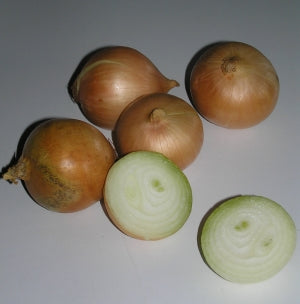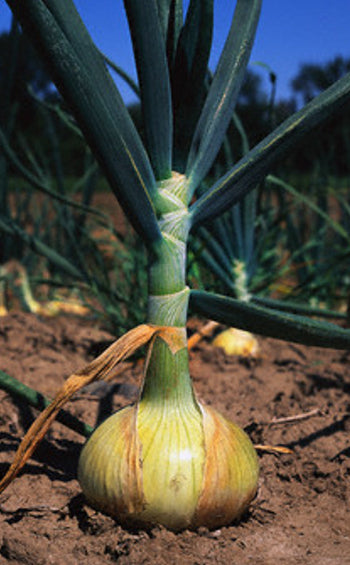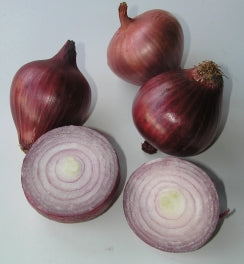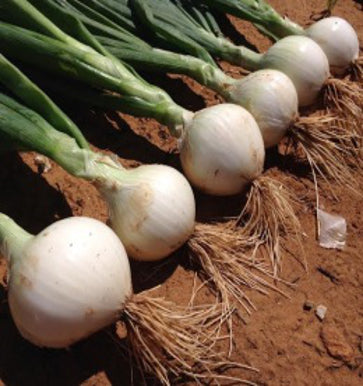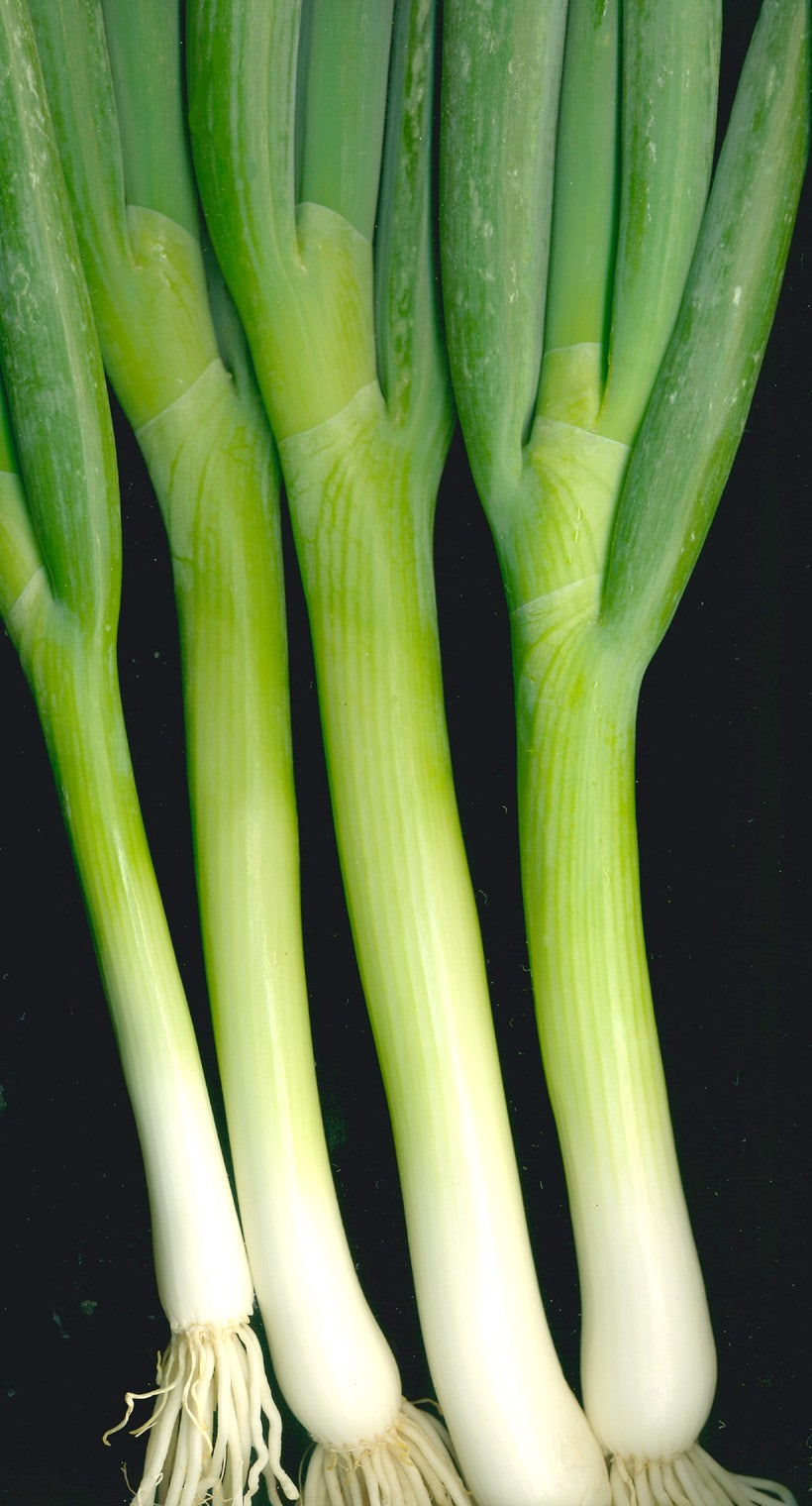How to Grow Onion & Shallot

The essential guide to growing onion and shallots from seed; with notes on germination, cultivation, harvest and even kitchen uses.
Know Your Alliums – Flavour & Kitchen Uses:
- Short-day bulb onions – mild, juicy whites, reds and yellows; best for fresh eating, grilling and quick pickles in warmer districts.
- Intermediate / day-neutral onions – balance of size and sweetness; reliable bulbing across most of Australia, good for everyday cooking.
- Long-day bulb onions – pungent browns and strong keepers; suited to cool-temperate zones, ideal for winter storage and slow caramelising.
- Bunching / Welsh onions (A. fistulosum) – hollow stems only, no bulb; slice into stir-fries, omelettes and salads. See our selection of spring onions.
- Shallots – cluster of small, sweet bulbs; mince for vinaigrettes, sauces and roasting whole. See our shallots.
More on the importance of day length below.
Seeds per Gram: ~250 – 350 seeds
Germination Temperature: 18 – 23 °C (germination in 7 – 10 days; slows <10 °C, patchy >28 °C)
Feed Requirements:
- Moderate.
- Work 5 cm compost plus a balanced organic fertiliser (about 60 g m⁻²) into the bed.
- Side-dress with nitrogen mix (eg. blood & bone) at 4-leaf stage and again when bulbs begin to swell.
Growing Notes:
Day-length & Variety Choice
Onions switch from making leaves to swelling bulbs when daylight reaches a critical number of hours that is hard-wired into each variety group.
- Short-day (SD) cultivars start bulbing once days hit 10–12 h.
- Intermediate / day-neutral (ID) cultivars trigger at 12–14 h.
- Long-day (LD) cultivars need 14–16 h before they bulb.
If you sow the wrong group for your latitude and season the plants either:
bulb too early (tiny onions), or never bulb at all (just lots of leaves).
Practical timing for Australia
| Latitude zone (approx.) | Group that bulbs well | When to sow seed¹ | When bulbing occurs | Harvest |
|---|---|---|---|---|
|
Sub-tropical (≤ 27 °S – Brisbane, Bundaberg) |
Short-day | late summer–autumn (Feb-Apr) | late winter (Aug) as day length climbs past 11 h | Sept-Oct |
|
Warm temperate (28–34 °S – Sydney, Perth, Adelaide) |
Short-day or Intermediates | SD: Mar–Apr • ID: Jun–Jul | SD: Aug–Sept • ID: Oct–Nov | SD: Sept–Oct • ID: Nov–Dec |
|
Cool temperate (35–38 °S – Canberra, Melbourne) |
Intermediate for autumn crop and Long-day for storage | ID: Feb–Mar • LD: Aug–Sept | ID: Oct • LD: Dec–Jan (15 h days) | ID: Nov • LD: Jan–Feb |
|
Cold / Tasmanian (> 38 °S) |
Long-day only | Aug–Sept | Jan (day length ~15 h) | Feb–Mar |
1 Sow seed 6-8 weeks earlier if you intend to raise transplants in trays.
Key points
- Short-day onions are planted while days are still short so plants make plenty of leaves through autumn–winter; they bulb just as the weather warms. In southern latitudes they’ll bulb too soon and stay small.
- Intermediates/day-neutral are the “all-rounders” and safest choice for most of the Australian mainland.
- Long-day onions must experience the very long days of late-December–January (south of about 34 °S) to size up; they are the classic brown “storage” types for cool regions.
Match the variety’s day-length requirement to when your local daylight hours reach its trigger, and sow far enough ahead (usually 12–16 weeks) that the plants have built a good canopy before bulbing begins.
Sowing & Spacing
- Seed trays: sow 5 mm deep in punnets 8 weeks before transplant; clip tops to 5 cm if lanky.
- Direct: sow a 2 cm-wide band 1 cm deep, 20 seeds/m; thin to 4 cm for storage bulbs or 2 cm for barbecue-size.
- Transplanting: set pencil-thick seedlings 4 cm apart in rows 30 cm apart; plant into a 10 cm-deep furrow then back-fill gradually to blanch shanks.
Soil & Water
- Sandy loam, pH 6.0 – 7.0, free-draining yet moisture retentive.
- Do not let soil dry out, especially during bulbing; water stress causes splits and strong flavour.
- Do not overwater! Water logged soils can can fungal issues.
Weed & Pest Care
- Onions hate competition – keep beds clean with shallow hoeing or straw mulch.
- Monitor for onion thrips (silver streaks) and treat with insecticidal soap or Eco-oil. This is more a problem for large commercial crops.
- Rotate in five years interval to help prevent diseases.
Harvesting:
- Green onions / scallions: pull any time stems reach 8 mm diameter.
- Bulb onions & shallots: when two-thirds of tops have bent over naturally, stop watering, wait one week, then lift with a fork.
- Curing: lay bulbs in a single layer under airy shade (or in-row sun curing for 3 days) until necks shrivel and skins rattle – about 2 weeks.
- Trim roots, clip tops to 3 cm and store in mesh bags at 0-4 °C and 65 % RH;
-
Storage Period:
- long-day browns keep 6 – 9 months,
- sweet short-day types 2 – 3 months.
Plant the right day-length seed, keep moisture steady and beds weed-free, and you’ll harvest crisp spring onions through to hefty winter keepers – plus sweet, clustered shallots for gourmet dishes all year round.
Sowing Periods
| J | F | M | A | M | J | J | A | S | O | N | D | |
|---|---|---|---|---|---|---|---|---|---|---|---|---|
| Cool | ||||||||||||
| Temperate | ||||||||||||
| Sub-Tropical/Tropical |
Filters
8 products

